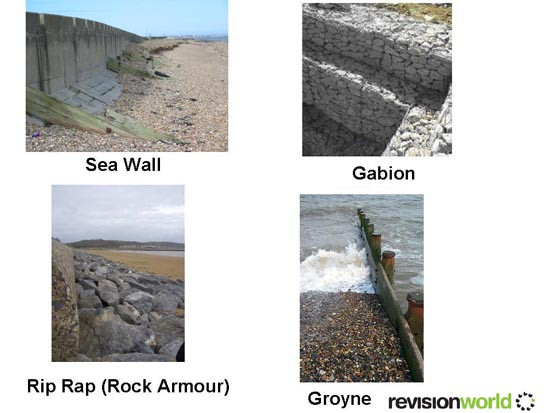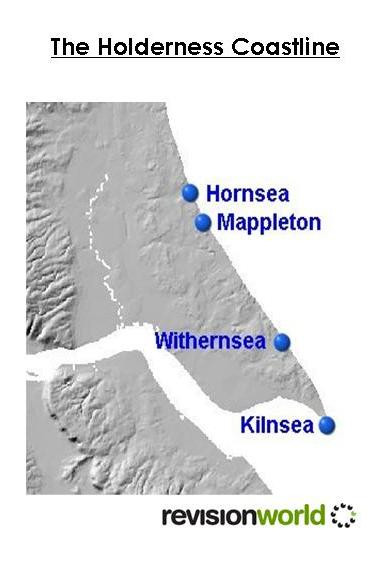The section covers
- Hard Engineering
- Soft Engineering
Managing coasts can be tricky. Techniques can be divided into hard engineering and soft engineering.
Hard Engineering
Advantages and disadvantages of hard engineering schemes
- Sea Wall: Placed at the base of a cliff to reflect the waves energy. They are very expensive at approximately £10,000 per km, but extremely effective at protecting areas from flooding. Environmentally ugly.
- Gabions: Cages of wire filled with rocks to absorb the waves energy, they are effective and cheap but environmentally ugly.
- Groynes: Can be made of wood or rock and are long vertical structures placed at right angles to the beach to trap sediment. This builds up the beach and protects the cliffs from erosion. They are effective at building up the beach therefore protecting cliffs from wave attack. Can result in areas further down the coast being starved of beach material resulting in more erosion! Only last 25-30 years.
- Rip Rap (Rock armour): Large rocks placed at the bottom of the cliff to absorb the wave energy, they are effective at dipersing the waves energy and cheap. Environmentally ugly and may put off tourists.
Examples of hard engineering

Soft Engineering
Soft Engineering is a less environmentally noticeable way of managing the coastline.
- Beach Nourishment: Large amounts of sand are added to beaches to build them up and help absorb wave energy. This protects tourism as well as the coast and is easy to carry out and fairly cheap. But it does not last very long as sand will continue to be transported along the coast by longshore drift.
- Managed Retreat: This allows the natural erosional processses of the sea to occur, areas of low value land are allowed to flood hopefully protecting more important areas further down the coast.
- Cliff Stabilisation: Cliffs are covered in matting and vegetation planted to help make them more stable and resistant to erosion.
- Do nothing: Obviously the cheapest and most environmentally friendly option! However, you have to weigh up the COSTS (to people, tourism and buildings) against the BENEFITS (advantages of letting the area return to its natural processes). If the costs greatly outweigh the benefits e.g. by having to rehome many people or losing valuable tourist facilities then other options will have to be looked at.
The Holderness Coastline in East Yorkshire is the fastest eroding coastline in the world

Case Study: Holderness
The Holderness coast is threatened by fast rates of erosion and in addition the beach areas, which are important for tourism around Mappleton, are being depleted at an alarming rate. (In some areas it is as fast as 5m per year)
Why? The cliffs are made of soft boulder clay therefore they are quickly eroded by the power of the sea and sun aerial processes (physical and biological weathering).
Problems
- 29 villages have been claimed by the sea in 1000 years
- Farmers are losing valuable farmland Holiday caravans have collapsed into the sea
- In June 1993 the Holbeck Hall Hotel slumped into the sea
- Sea defences at Mappleton are causing problems further along the coast as there is less sediment to travel down
Solutions
- £2 million was spent on putting in a ‘rip rap’ large granite blocks to absorb the waves energy at Mappleton
- 2 rock groynes were erected to build up the beach at Mappletopn
- A sea wall has been erected at Eastington to protect the gas station
- Offshore reefs of old tyres along the coastline

